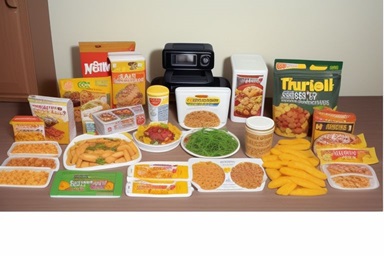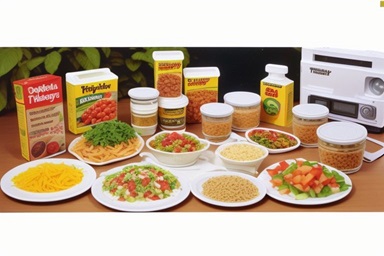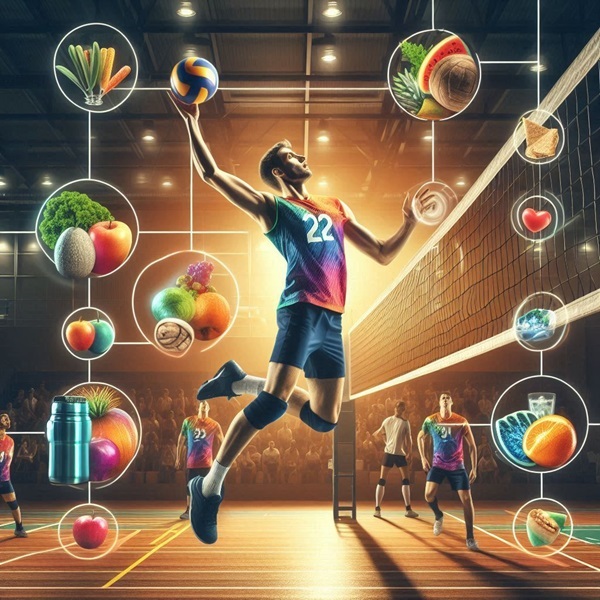Spike Your Performance: Essential Nutrition Tips for Volleyball Players
Fueling Success on the Court
Volleyball is a high-intensity sport that demands both physical endurance and sharp mental focus. Whether you’re playing beach volleyball under the scorching sun or diving for spikes in an indoor court, the right nutrition can make or break your performance. Just as training strengthens your body, a well-balanced volleyball diet gives you the energy, strength, and stamina you need to thrive. From pre-game meals to post-game recovery foods, nutrition is the hidden factor that can unlock peak performance.
In this comprehensive guide, we will explore how to tailor nutrition for volleyball players to meet the unique demands of the sport. We’ll dive into key topics such as athlete nutrition, performance nutrition, hydration, and protein intake, with a special focus on how proper eating habits enhance endurance, speed, and overall fitness. As a volleyball player or coach, understanding these principles can help you or your team achieve new heights in performance and recovery.
Volleyball Nutrition
1.1 Understanding the Energy Demands of Volleyball
Volleyball, like other team sports, involves bursts of high-intensity activity followed by short periods of rest. The unique physiological demands of volleyball differ between positions and from one match to another, but one thing remains constant: the need for a strategic volleyball diet that supports energy needs, recovery, and overall performance.
A volleyball player’s nutrition must focus on several key areas:
- Supporting body composition (muscle mass, lean physique)
- Fueling training sessions and matches efficiently
- Maintaining hydration and nutrient levels
The caloric needs for volleyball players are higher than in many other sports because of the combination of muscle growth, strength training, and skill-based movements that each player requires. For example, players like setters or middle blockers may have different energy and nutritional requirements, depending on their position and the intensity of their play【18†source】.
Achieving Adequate Energy Availability
One of the most important aspects of athlete nutrition is ensuring that players consume enough energy to meet the demands of their training and competition schedules. When energy intake is too low, it can negatively impact muscle protein synthesis, bone health, and immune function. The concept of Relative Energy Deficiency in Sport (RED-S) highlights the dangers of insufficient caloric intake, particularly in sports like volleyball where high performance is required over extended periods【18†source】.
1.2 Building a Balanced Volleyball Diet
To fuel both training and matches, volleyball players must prioritize a balanced diet that includes:
- Carbohydrates: As the primary energy source for athletes, carbs should make up a significant portion of a volleyball player’s diet. Carbohydrates provide the muscle glycogen necessary for intense physical activity, especially during long matches or demanding training sessions.
- Proteins: Proteins are crucial for muscle repair and growth, particularly after workouts or matches. Volleyball players should consume around 1.2–2.0 g/kg of protein per day, with 20-25g of high-quality protein post-exercise to optimize recovery【18†source】.
- Healthy Fats: While carbs and protein are essential, healthy fats play a critical role in maintaining long-term energy levels, supporting brain function, and aiding in the absorption of fat-soluble vitamins.
A typical volleyball meal plan should include nutrient-rich foods that support energy, endurance, and recovery. Some examples of energy-boosting foods include:
- Whole grains like brown rice and quinoa
- Lean proteins such as chicken, fish, and eggs
- Healthy fats from avocados, nuts, and seeds
- Fruits and vegetables that provide vitamins, minerals, and antioxidants
1.3 Importance of Protein for Volleyball Players
For muscle growth and recovery, protein plays an indispensable role. Protein timing—the strategic consumption of protein throughout the day—helps volleyball players maximize their strength and adaptation to training. Studies show that spreading protein intake evenly over meals, rather than consuming it all at once, promotes muscle synthesis more effectively【18†source】.
Here are some tips to enhance protein intake:
- Aim to consume 0.3 g/kg of body mass of high-quality protein, such as lean meats, dairy, or plant-based sources, after each training session.
- Spread protein intake across 4–5 meals and snacks throughout the day to promote ongoing recovery and muscle adaptation.
- Include high-protein snacks such as yogurt, smoothies, or protein bars to support muscle recovery during busy tournament days【18†source】.
1.4 Carbohydrates: The Fuel for Performance
Carbohydrates are the key energy source for any volleyball player. On match days, athletes need to focus on consuming enough carbs to top off glycogen stores. Without adequate glycogen, fatigue sets in faster, and performance suffers.
For sustained energy throughout training and competitions, volleyball players should adjust their carbohydrate intake based on their activity level:
- Light training day: 3–5 g of carbohydrates per kg of body weight
- Moderate training day: 5–7 g of carbohydrates per kg
- Heavy training/match day: 6–10 g of carbohydrates per kg【18†source】
Athletes should consume complex carbohydrates such as whole grains, fruits, and vegetables, which provide a steady release of energy. Before matches, players should eat a carbohydrate-rich meal 1-4 hours before competition to ensure maximum fuel availability during play.
1.5 Hydration for Volleyball Players
Staying hydrated is one of the simplest yet most overlooked factors in performance nutrition. Dehydration can significantly impair volleyball performance, reducing endurance and mental sharpness while increasing the risk of cramps and injury.
Volleyball players need to replace fluids lost through sweat during both training and matches. For optimal performance, they should:
- Drink 500-600ml of water 2-3 hours before a game
- Consume 200-300ml of fluids 10-20 minutes before activity
- Hydrate regularly during games, particularly during timeouts or breaks
Sports drinks that contain electrolytes can also help replenish lost sodium and potassium, especially during long tournaments or matches played in hot environments【18†source】.

Proven Strategies for Volleyball Nutrition
2.1 Pre-Game Nutrition: Setting the Foundation for Success
What volleyball players eat before a match can directly impact their performance on the court. Pre-game meals should focus on providing long-lasting energy while being easy to digest. The goal is to avoid heavy or fatty foods that can slow down digestion and cause discomfort during play.
Some examples of ideal pre-game meals include:
- Oatmeal with fruit: A slow-digesting carb source paired with natural sugars from fruits.
- Grilled chicken with brown rice: A balanced combination of lean protein and complex carbs.
- Greek yogurt with granola: A light, protein-packed snack that won’t weigh players down【18†source】.
If you are a fan of frying, you can use olive oil. for example fried eggs, fried chicken and … but remember to use the least amount of it.
Timing is just as important as the content of the meal. Players should aim to eat 2-4 hours before a match, giving their body enough time to digest the food and convert it into usable energy.
2.2 Post-Game Recovery Nutrition
After a tough match or practice, the body enters recovery mode. To speed up recovery, players should focus on replenishing glycogen, repairing muscle tissue, and rehydrating. This means consuming a post-game meal or snack within 30 minutes to an hour of finishing.
An effective post-game recovery meal includes:
- Carbohydrates to replenish muscle glycogen
- Protein to support muscle repair
- Fluids to rehydrate
For example:
- A protein shake with added carbs (such as a banana or oats) provides an easy, portable option for tournaments.
- A balanced meal of grilled salmon, quinoa, and steamed vegetables offers recovery-enhancing nutrients【18†source】.
2.3 Supplements for Volleyball Players
While most of an athlete’s nutritional needs should come from whole foods, certain sports supplements can provide additional support during intense training or recovery phases. Some volleyball players use whey protein to meet protein requirements or sports drinks to boost electrolyte levels after extended periods of play. However, supplements should be used cautiously and only when necessary, as they can sometimes have side effects or interact with other nutritional components. It’s also important to consider the differences between male and female athletes, as their responses to supplements may vary due to physiological factors like muscle mass, metabolism, and hormone levels.
Here are some supplements that may benefit volleyball players:
1. Whey Protein
Whey protein is a popular supplement used by both male and female volleyball players to support muscle repair and growth. For male players, who typically have higher muscle mass, whey protein helps meet the increased protein demands necessary for maintaining and building lean muscle, particularly during periods of intense strength training. Female athletes, while having lower muscle mass on average, still benefit from whey protein for muscle recovery, especially after high-intensity training or match days. It is convenient for busy athletes who may struggle to meet their protein targets through whole foods alone.
2. Creatine
Creatine is one of the most studied and effective supplements for enhancing short bursts of power and strength, which are critical in volleyball for activities like jumping and spiking. For male players, creatine has been shown to increase muscle mass, improve recovery times, and enhance overall explosive performance. Female players, though sometimes hesitant to use creatine due to concerns about water retention or weight gain, can also benefit from increased muscle power and recovery. Studies show that creatine supplementation can improve performance for both genders without significant differences in effects, though dosage may vary based on body weight and size.
3. Caffeine
Caffeine is a well-known stimulant that improves focus, endurance, and alertness, especially useful during the late stages of a game when fatigue sets in. For male players, caffeine helps enhance physical performance by improving reaction times and increasing endurance during long matches. Female players also experience improvements in focus and stamina with moderate caffeine intake, though they may be more sensitive to its effects due to lower body mass and slower metabolism of caffeine. Care must be taken to avoid excessive consumption, which can lead to side effects like jitteriness or impaired sleep.
However, it’s important to note that caffeine consumption can lead to episodes of low energy afterward. To avoid this, refrain from using caffeine from the beginning. Always consider the timing of caffeine intake in relation to the goals of the match and consult your team’s healthcare provider.
4. Beta-Alanine
Beta-alanine is a non-essential amino acid that helps buffer lactic acid in muscles, delaying fatigue during high-intensity exercise. Male volleyball players tend to see significant improvements in endurance, particularly during repetitive explosive movements like blocking or diving for the ball. Female players can also benefit from beta-alanine supplementation, particularly in maintaining high performance throughout long sets. However, both genders may experience tingling sensations (paresthesia) as a side effect, which can be managed by taking smaller doses.
5. Branched-Chain Amino Acids (BCAAs)
BCAAs (leucine, isoleucine, and valine) are critical for muscle repair and reducing exercise-induced fatigue. Male players benefit from BCAAs due to their role in preventing muscle breakdown, especially during long training sessions or back-to-back matches. For female athletes, BCAAs can aid in muscle recovery and reduce soreness, allowing quicker recovery between matches or training days. BCAAs also support muscle retention during calorie-restricted periods, which may be more relevant for female athletes focusing on maintaining a lean physique.
6. Iron Supplements
Iron is particularly important for female volleyball players, who are more prone to iron deficiencies due to menstrual blood loss. Iron deficiency can lead to fatigue, reduced endurance, and impaired recovery. Supplementing with iron, when necessary, helps maintain optimal oxygen transport and energy production. Male players, though less likely to suffer from iron deficiency, may still benefit if they experience intense training loads that increase their iron needs, such as during tournament seasons.
7. Electrolyte Supplements
Electrolytes (sodium, potassium, magnesium) are essential for maintaining fluid balance and preventing muscle cramps during and after long matches. Male players often lose significant amounts of electrolytes through sweat due to higher muscle mass and sweat rates, making replenishment crucial. Female players also need to ensure proper electrolyte balance to avoid dehydration and maintain muscle function, though their requirements may be slightly lower due to smaller body size and different sweat rates.
8. Omega-3 Fatty Acids
Omega-3 fatty acids, typically found in fish oil supplements, have anti-inflammatory properties that aid in joint health and recovery from muscle soreness. Male players, who may experience more muscle inflammation due to higher training intensities, benefit from the anti-inflammatory effects that help in faster recovery. Female players also benefit from omega-3s for reducing inflammation and supporting cardiovascular health, though dosage may vary depending on body size and dietary intake.
9. Vitamin D
Vitamin D is essential for bone health, muscle function, and immune support. Female volleyball players, particularly those who play indoors or live in regions with less sun exposure, are at higher risk for Vitamin D deficiency, which can affect bone density and increase the risk of stress fractures. Male players also require adequate Vitamin D levels to support muscle strength and reduce injury risk, though they may have slightly lower requirements compared to their female counterparts.
10. Multivitamins and Minerals
Multivitamins provide a comprehensive range of vitamins and minerals that may be lacking in an athlete’s diet. Both male and female volleyball players benefit from multivitamins during periods of intense training or calorie restriction, which may deplete nutrient stores. Specific attention should be given to minerals like magnesium and calcium for muscle function and bone health, particularly for female players who may have higher calcium needs to prevent bone-related injuries.
11. Glutamine
Glutamine is a non-essential amino acid that plays a crucial role in muscle recovery and immune function. For volleyball players, glutamine supplementation can help reduce muscle soreness and promote faster recovery after intense training sessions. It also supports the immune system, which is important for athletes who undergo frequent physical stress. Studies suggest that both male and female athletes can benefit from glutamine, especially during periods of heavy training or competition, as it helps to prevent muscle catabolism and supports overall recovery.
12.Taurine
Taurine is an amino acid that is involved in cardiovascular health, muscle function, and hydration. For volleyball players, taurine may enhance performance by improving muscle contraction efficiency and reducing exercise-induced oxidative stress. It has also been shown to aid in hydration and electrolyte balance, making it particularly useful during long matches or high-intensity training. Both male and female players can benefit from taurine supplementation, as it may support endurance, reduce muscle fatigue, and enhance recovery.
Players should always consult with a nutritionist or dietitian before introducing any supplements into their routine to ensure they’re used safely and effectively.

How to Build a Sustainable Volleyball Diet
3.1 Planning for Success
A volleyball player’s success depends not only on what they eat but how they plan their meals around their training and competition schedule. A well-structured volleyball meal plan should cover:
- Pre-game meals to fuel performance
- Post-game meals to enhance recovery
- Daily nutrition that maintains energy, supports muscle growth, and promotes overall health
Volleyball players should also adapt their diets based on seasonal changes, training intensity, and individual body composition goals. For instance, an off-season meal plan may prioritize lean muscle gain with more protein and fewer carbs, while in-season nutrition focuses on maintaining endurance and peak performance.

Maximize Your Volleyball Performance with the Right Nutrition for Male and Female Volleyball Players
When it comes to volleyball nutrition, both male and female athletes have unique dietary needs shaped by physiological, hormonal, and metabolic differences. These differences impact how they metabolize energy, respond to training, and recover after intense physical activity. Understanding these distinctions is crucial for optimizing performance and reducing the risk of injury for both genders.
1. Caloric Needs and Energy Availability
Males generally have higher muscle mass and metabolic rates compared to females, which means they require a higher caloric intake to meet their energy demands. Male volleyball players often need more calories to support muscle hypertrophy and strength, particularly when engaged in intensive strength training.
In contrast, female volleyball players must carefully balance their energy intake, as they are more prone to low energy availability and conditions like Relative Energy Deficiency in Sport (RED-S). This syndrome affects not only athletic performance but also bone health, menstrual function, and overall well-being. Women, especially those participating in sports with high physical demands, are at greater risk of under-consuming calories, leading to fatigue, decreased bone density, and a higher risk of stress fractures or other injuries.
2. Hormonal Fluctuations and Recovery
Female athletes face unique challenges due to the influence of hormonal fluctuations from the menstrual cycle. These hormonal changes can impact energy levels, muscle recovery, and overall performance. For instance, during the luteal phase (the second half of the menstrual cycle), women may experience a slight drop in endurance and strength, coupled with an increased need for recovery.
Male volleyball players, on the other hand, experience relatively stable testosterone levels, which help maintain muscle growth and recovery throughout the training cycle. This consistency allows men to engage in more intense training sessions and recover faster, provided they consume adequate nutrients.
Solutions to Address Hormonal Effects:
- For female players, it is crucial to monitor energy intake throughout the menstrual cycle. Increasing the intake of iron-rich foods (e.g., red meat, leafy greens) during menstruation can help combat fatigue and low energy levels due to iron loss
- Strategic meal planning around training sessions, particularly in the luteal phase, can help female players maintain their energy levels and recover more effectively.
- Coaches should also account for potential performance fluctuations during different phases of the menstrual cycle and adjust training intensity accordingly.
3. Protein and Muscle Synthesis
Protein needs differ between male and female volleyball players due to differences in muscle mass. Males, having more muscle mass, typically require higher protein intake to support muscle recovery and growth. Studies suggest that male athletes may benefit from consuming 1.6-2.0 g/kg of protein per day, particularly if they are engaged in strength and endurance training
For female volleyball players, protein requirements are generally lower but still significant. Consuming 1.2-1.6 g/kg of protein per day can support muscle recovery and hormonal health. However, female athletes may need to pay more attention to protein distribution throughout the day to promote muscle repair and prevent muscle loss, especially during times of caloric restriction.
4. Bone Health and Calcium Intake
Females are at a higher risk of bone health issues, particularly if they experience low energy availability or irregular menstrual cycles. Adequate calcium and vitamin D intake is essential to prevent injuries related to poor bone density, such as stress fractures.
- Males also need to maintain healthy bones, but their higher testosterone levels generally offer more protection against bone density loss. However, during intense training periods, both genders should ensure adequate calcium intake (1,000-1,300 mg per day).
Solutions for Maintaining Bone Health:
- Both male and female volleyball players should include calcium-rich foods such as dairy, fortified plant milks, and leafy greens in their diets.
- Supplementation with vitamin D may be necessary, especially for female players who train indoors or live in areas with limited sun exposure.
5. Fat Metabolism
Females tend to rely more on fat metabolism during exercise than males, who are more dependent on carbohydrates. This difference in fuel utilization means female players may benefit from consuming more healthy fats (e.g., avocados, nuts, seeds) to meet their energy needs, while males should focus more on carbohydrate intake to sustain performance.
Minimizing Injury Risks Due to Gender Differences
Given the differences in energy needs, hormonal influences, and recovery patterns, specific strategies can help reduce the risk of injury for both male and female volleyball players:
1. Tailored Training Programs
Coaches and trainers should design gender-specific training programs that account for these physiological differences:
- For females, the training intensity may need to be adjusted during certain phases of the menstrual cycle to reduce fatigue and lower the risk of injury. Focus on recovery strategies like active rest or low-impact exercises during this time.
- For males, training programs can focus more on strength and power development, but should still incorporate recovery days to prevent overuse injuries.
2. Monitoring Energy Availability
Both genders need to ensure they are consuming enough calories to meet their training demands. Female athletes, in particular, must avoid prolonged periods of low energy availability by including high-calorie, nutrient-dense foods in their diets.
3. Addressing Nutrient Deficiencies
Identifying and addressing common deficiencies, such as iron in female athletes or vitamin D for both genders, is essential for preventing fatigue, bone issues, and muscle breakdown. Regular blood tests and nutritional assessments can help ensure players meet their micronutrient needs.
4. Injury Prevention Protocols
Volleyball players, regardless of gender, should adopt prehabilitation programs that focus on strengthening muscles around vulnerable joints (such as the shoulders and knees). This can be paired with:
- Dynamic warm-ups to improve flexibility
- Strengthening exercises to enhance stability
- Stretching routines post-game to prevent stiffness and reduce injury risk
Are you ready to take your game to the next level? Share your experiences with volleyball nutrition or ask your questions in the comments below!


